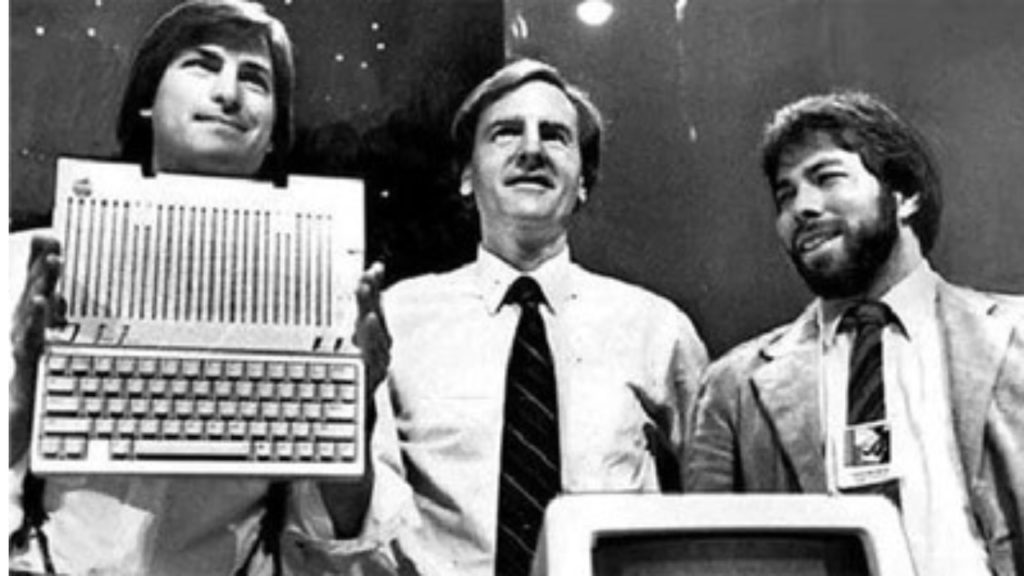Steve Jobs, co-founder of Apple, was one of the most iconic and innovative figures in the world of technology. His career has been marked by ups and downs, revolutions in the technology sector and an immersive vision that has changed the way the world interacts with technology. Born in 1955, Jobs grew up in an era of technological transformations that he himself would help shape. This article will explore the story of Steve Jobs, from his childhood to the lasting legacy he left the world.
Childhood and Adolescence
Steven Paul Jobs was born on February 24, 1955, in San Francisco, California. His biological parents, Abdulfattah Jandali, a Syrian immigrant, and Joanne Schieble, an American of Swiss-German descent, were university students and were not prepared to raise a child. Jobs was adopted by Paul and Clara Jobs, who lived in Mountain View, California, a city located in the heart of Silicon Valley, the epicenter of technological innovation.
From an early age, Jobs was a curious and restless child. He developed an interest in electronics with the encouragement of his adoptive father, Paul, who taught him to take apart devices to understand how they worked. This fascination with technology and innovation was one of the main drivers of his journey.
Jobs attended Homestead High School in Cupertino, where he had an average academic record, but stood out for his ability to think outside the box. It was during this period that he met Steve Wozniak, a young electronics prodigy who would later become his partner in the creation of Apple.
The Creation of Apple

In 1972, Jobs entered Reed College in Portland, but dropped out after one semester. However, he continued to attend some classes, including one in calligraphy, which would later influence the typography of Apple's first computers. This quest for knowledge in various fields, without concern for academic conventionality, was a defining characteristic of his personality.
In 1976, Jobs, together with his friend Steve Wozniak and Ronald Wayne, co-founded Apple Computer, Inc. in Jobs' parents' garage in Cupertino. Apple's first major project was the Apple I, a personal computer that Wozniak designed and Jobs marketed. The success of the Apple I allowed them to officially found Apple with the launch of the Apple II, which revolutionized the personal computer industry. This product was a milestone in the history of computing, as it made computers accessible to the general public, no longer just a tool for engineers and scientists.
The Rise and Fall of Apple
Apple grew rapidly during its early years, becoming one of the most valuable companies in Silicon Valley. However, in 1985, Jobs had a falling out with Apple's management, which led to his departure from the company. This departure was a turning point in his life and career. Jobs described this period as a phase of "rebirth", and he went on to make history.
After leaving Apple, Jobs founded NeXT, a computer company aimed at the educational and business markets. Although NeXT computers did not achieve great commercial success, the company was responsible for technological innovations, such as the introduction of the NeXTSTEP operating system, which later served as the basis for Apple's Mac OS X.
In 1986, Jobs acquired a small animation company called Pixar. Under his leadership, Pixar became a successful digital animation studio, producing films such as Toy Story (1995), the first feature film created entirely by computer graphics. Pixar was sold to Disney in 2006 for 7.4 billion dollars, making Jobs one of Disney's largest shareholders and one of its board members.
Apple's Triumphant Return
In 1997, Apple was on the verge of bankruptcy, and the company's management decided to call Jobs back. His return to Apple marked the beginning of an era of innovation that would transform the company and the world of technology. Jobs brought with him a vision focused on elegant design, simple functionality and the integration of hardware and software in a way that no other computer manufacturer had achieved.
The first major launch under Jobs' leadership was the iMac, an innovative personal computer that broke with traditional PC design. Apple followed with a series of revolutionary products, including the iPod (2001), a digital music player that transformed the music industry, the iPhone (2007), which redefined the concept of the cell phone, and the iPad (2010), which popularized tablets.
The iPhone, in particular, radically changed the way people communicate, interact with the world and consume digital content. It wasn't just a cell phone, but an open software platform for developers, who created millions of applications that extended its functionality. Apple became the largest company in the world by market value, an impressive feat given its precarious financial state at the time of Jobs' return.
Philosophy of Design and Innovation

One of Jobs' most striking characteristics was his design philosophy. He believed that technology should be simple and intuitive, while also being beautiful. His obsession with perfect design and user experience was evident in every product launched by Apple. Jobs was not only concerned with the functionality of devices, but also with their aesthetics, and his attention to detail was reflected in the look and feel of everything Apple produced.
He also believed that companies should not only create products that meet consumer needs, but that they should anticipate those needs and create products that people didn't even know they wanted. This philosophy was central to the way Apple developed its innovative products, anticipating trends and shaping the future of technology.
The Legacy of Steve Jobs
Steve Jobs passed away on October 5, 2011, after a long battle with pancreatic cancer. His death was a blow to the world of technology, but his legacy lives on in the innovations he helped create and in Apple, which remains one of the most influential companies on the planet.
Jobs was not just an entrepreneur or inventor; he was a visionary who had the ability to see the future and turn it into reality. His approach focused on design and user experience set new standards for the technology industry. The impact of his products, from the iPhone to personal computers, has changed the way we interact with technology and how it permeates our daily lives.
In addition, Jobs left a legacy in the world of entrepreneurship, teaching future business leaders the importance of following their passion, challenging the status quo and never giving up on their visions. He is remembered as one of the greatest innovators of the 20th century, and his influence continues to shape the future of technology.
Conclusion
The story of Steve Jobs is one of innovation, resilience and vision. Not only did he found one of the most powerful companies in the world, but he also redefined the way we think about technology. His ability to see the potential in the future and his dedication to turning that potential into reality made him a unique and unforgettable figure. Steve Jobs' legacy is an example of how a single person can change the course of history and leave an indelible mark on the world.


